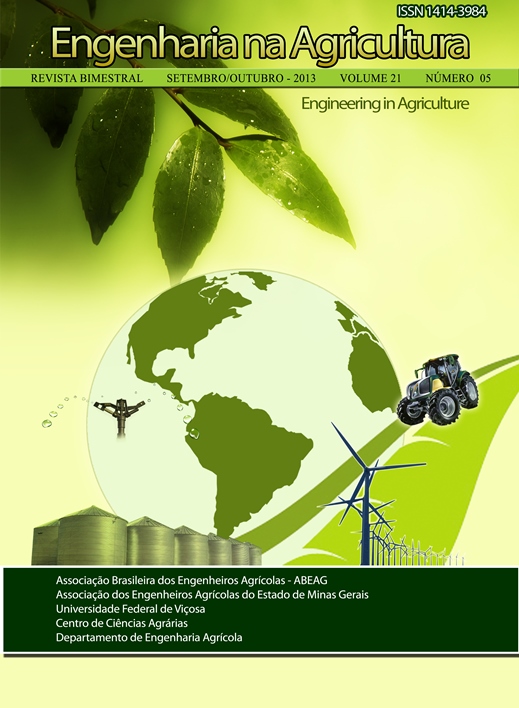CRESCIMENTO E RENDIMENTO PRODUTIVO DO FEIJOEIRO SUBMETIDO À RESTRIÇÃO HÍDRICA
DOI:
https://doi.org/10.13083/reveng.v21i5.416Palavras-chave:
Phaseolus vulgaris, déficit hídrico, análises de crescimento, produçãoResumo
A cultura do feijoeiro é afetada pelas condições climáticas, sendo o desenvolvimento das plantas influenciado pelo estresse hídrico. Um dos modos de se suprir as necessidades das plantas é por meio da irrigação. Dessa forma, buscou-se investigar neste trabalho o crescimento vegetativo e o rendimento produtivo do feijoeiro submetido à restrição hídrica durante o seu ciclo. Para esta finalidade, plantas de feijoeiro cultivar Manteiga foram cultivadas em vasos de 5 dm3 e submetidas aos tratamentos de 50 e 100% da capacidade de campo. Os parâmetros analisados foram: altura da planta, área foliar, número de nódulos do sistema radicular, matéria seca da parte aérea, da raiz e total, massa seca de grãos e número de grãos e de vagens. De acordo com os dados obtidos, foram determinados os seguintes índices de crescimento: incremento de matéria seca total, do caule, da folha, e da raiz. O experimento foi realizado em casa de vegetação, no Campus da Universidade Federal de Viçosa, disposto num delineamento experimental de blocos casualizados, em esquema de parcelas subdivididas no tempo, com quatro repetições. Os resultados obtidos mostraram que houve um menor crescimento vegetativo e menor rendimento produtivo nas plantas submetidas à restrição hídrica, imposta pelo tratamento de 50% da capacidade de campo, evidenciando a necessidade do controle adequado de água no solo como estratégia de manejo adequado para a produção.Downloads
Downloads
Publicado
Como Citar
Edição
Seção
Licença
Autores que publicam nesta revista concordam com os seguintes termos:
O(s) autor(es) autoriza(m) a publicação do texto na da revista;
O(s) autor(es) garantem que a contribuição é original e inédita e que não está em processo de avaliação em outra(s) revista(s);
A revista não se responsabiliza pelas opiniões, ideias e conceitos emitidos nos textos, por serem de inteira responsabilidade de seu(s) autor(es);
É reservado aos editores o direito de proceder a ajustes textuais e de adequação às normas da publicação.
A partir da submissão, o autor estará cedendo integralmente seus direitos patrimoniais da obra à publicação, permanecendo detentor de seus direitos morais (autoria e identificação na obra) e de acordo com a Licença Creative Commons, CC BY-NC.








 Esta obra está licenciada com uma Licença
Esta obra está licenciada com uma Licença 